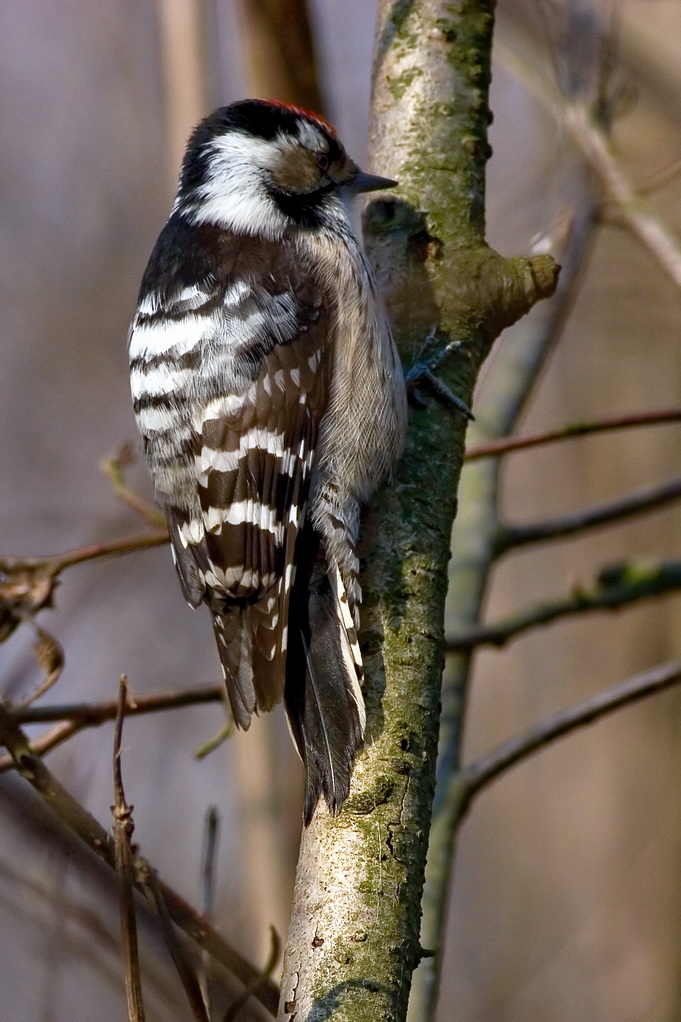Lesser Spotted Woodpecker
From Wikipedia, the free encyclopedia
[Photo] Lesser Spotted Woodpecker (Picoides minor). Photo taken near Vanhankaupunginlahti, Finland. The location is listed in Ramsar "List of Wetlands of International Importance". Geographic location 60º12’N 024º54’E. Date 24 March 2007. Author Thermos
The Lesser Spotted Woodpecker (Picoides minor) is a member of the woodpecker family Picidae. It was previously assigned to the genus Dendrocopos (sometimes incorrectly spelt as Dendrocopus), and often still is, but it appears to be closer related to the Downy Woodpecker.
The range of the Lesser Spotted Woodpecker is the Palearctic region, but several subspecies are recognised.
Description
From its small size and its habit of spending most of its time in the tops of tall trees in woods and parks, this little woodpecker is often overlooked, but if sighted on a trunk it may at once be identified by the broad barring on the wings and narrower bars across the lower back.
The male has a crimson crown, a brown forehead, a black superciliary stripe, and another from the base of the bill to the neck. The nape and upper back are black, but the lower back is barred with black and white. On the wings are broader and more conspicuous bars, and the outer tail feathers are also barred. The under parts are white with streaks on the flanks. The bill and legs are slate-grey.
In the female the crown is white, but the young birds of both sexes have more or less crimson on the head. There are no marked seasonal changes.
Ecology
Its habits are very similar to those of the Great Spotted Woodpecker, and it has the same stumpy appearance, almost triangular, when bounding from tree to tree. Its note is a repeated "keek", loud for so small a bird, and its vibrating rattle can with experience be distinguished from that of the larger species. This substitute for a song may be heard at all times, but most frequently when courtship begins early in the year.
Its insect food is similar to that of the Great Spotted Woodpecker. When hunting for wood-boring larvae it chips away at the rotten wood, and the litter at the foot of a tree is often the first indication that insects are attacking upper branches. From autumn to spring it hunts mainly on wood-living insect larvae, frequently from thin dead branches in living trees. Through the breeding season, surface-living insects from the foliage and bark of trees make up an increased amount of the diet. Nestlings are mainly fed with surface-living insects,such as aphids and larval insects. At night it roosts in old holes.
A litter of chips is also a guide to a nesting hole, for the bird does not always carry these away when excavating. The hole is usually at a considerable height above the ground and may be so high as 30 or 40 feet. It is a smaller burrow than that of the Great Spotted Woodpecker, measuring from 1 to 2 inches in diameter.
The shaft varies, the nesting cavity being often a foot or more below the entrance. Five to eight highly polished white eggs are laid upon wood dust and chips in the latter half of May, and a single brood is the rule. Both birds help to incubate. Occasionally an old or natural hollow is used or enlarged.
Populations of Lesser Spotted Woodpeckers are mostly resident, but can be nomadic to some degree. Annual fluctations in population numbers are common. The winter temperatures may exhibit a direct effect on winter survival of Lesser Spotted Woodpeckers by heat loss, whereas weather conditions during spring have an indirect effect on breeding performance by affecting food production.
http://en.wikipedia.org/wiki/Lesser_Spotted_Woodpecker
| The text in this page is based on the copyrighted Wikipedia article shown in above URL. It is used under the GNU Free Documentation License. You may redistribute it, verbatim or modified, providing that you comply with the terms of the GFDL. |
|

